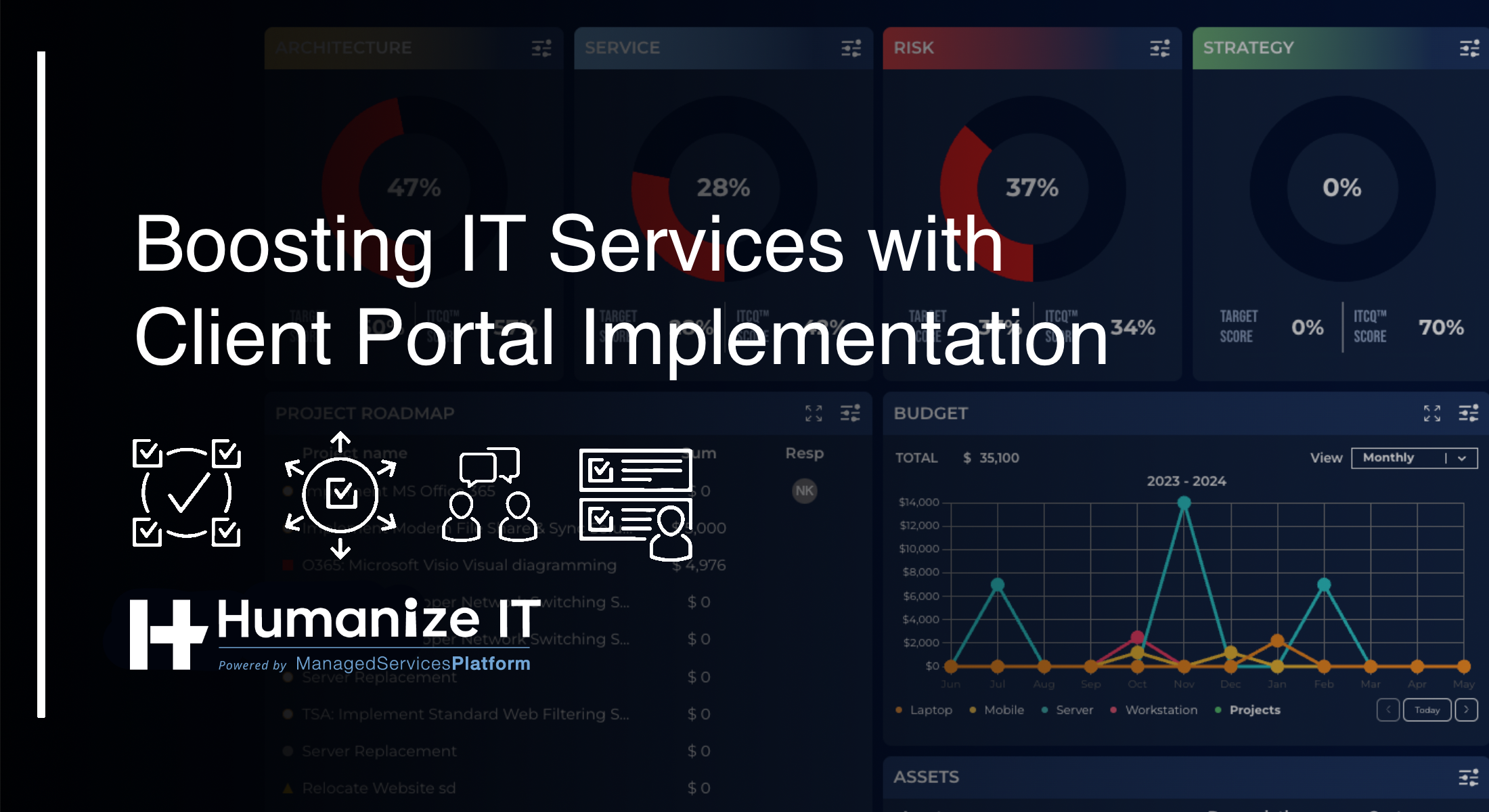Client portal implementation is a critical process that can enhance IT insights and improve the overall client experience. With careful planning, it can offer personalized views, provide high-value marketing collateral through lead gen, and even incorporate mock budgets for added benefits.
8 min read
Boosting IT Services with Client Portal Implementation
By Adam Walter on Jun 26, 2023
Topics: CIO QBR Win New Clients Client Success Client Portal
3 min read
The Biggest Problem Facing MSPs Today
By Adam Walter on Jan 23, 2023
We have been spending a lot of time talking to MSPs and other vendors over the last few months. Something has been bugging us, we can't quite put our fingers on it but something has changed in the marketplace.
Topics: IT Sales MSP CIO Disruptive MSP Humanize Podcast
4 min read
Lessons Learned 2022
By Adam Walter on Dec 5, 2022
We are nearing the end of the year, so you know what that means: it’s time for 2022’s Lessons Learned. Lessons Learned is an opportunity for an MSP (or any business!) to discuss the actions they can take to either mitigate a problem or increase success. It’s best conducted at the end of the year so that you can thoroughly analyze everything that happened during the previous 12 months.
You’re probably assuming that Lessons Learned focuses on mistakes made during the year, and what you learned from them – hence, “lessons learned.” While pitfalls are definitely a central topic of discussion, the successes of the year are equally as important to talk about. When things are going well, do you understand why? You need to pinpoint the key to the success you have reached so that you can continue it into the new year.
Topics: CIO Strategic Leadership QBR
3 min read
Happy Holidays
By Adam Walter on Nov 28, 2022
Happy Holidays from Humanize IT!
People in the IT industry treat the holidays a little differently than everyone else. Some really look forward to the break from the office and the time they get to spend with their families. Others see it as a great opportunity to earn overtime pay while they catch up or get ahead on important projects. And, of course, there are those who look at the upcoming holiday break on the calendar, and think to themselves…man, this is going to be rough. Whether they’re going to be working through the holiday to keep the system running or the time away from the office may potentially make the following week a little more stressful, those of us in IT completely understand that feeling – we’ve all been there.
Topics: CIO holidays
2 min read
Right Person, Right Seat
By Adam Walter on Jul 25, 2022
Apple Podcasts: https://apple.co/2NHRRDl
Spotify: https://spoti.fi/3AyHCUd
Youtube: https://youtu.be/wJKWn98LKWs
So, you’ve started a company. Great! Now the hard part; finding people to run it. Many companies look at their employees as nothing more than bodies in a seat. Once a seat is empty, they’ll look for anyone to replace it. But running a company is more than just ensuring that seats are filled. Your company’s mission statement and culture not only tell your story, it tells your employees who you are, what you value and how they are a part of your vision. It’s important that you hire people who possess more than just the skills or education needed to do their job. Find people who care!
Establishing the culture of your company is crucial in hiring the right people. Many individuals may have all the qualifications to fill a needed position. But if they’re not a good fit for your company culture, hiring them will only hurt them and your company. When you talk to potential new hires, make sure you make your company culture clear. How do you operate? What do you value? How do your employees and executives interact and communicate? Pay attention to a candidate’s approach and demeanor. They're not the right fit if they don’t align with your company culture.
Your mission statement needs to be clear and unique. Find your “it.” How does your “it” make you the best at what you do? Mediocre and generic mission statements make for mediocre and generic passion from your staff. Live that mission statement every day with enthusiasm. Attitude is like a wildfire. It spreads to everyone, including new employees. When your staff talks to their peers about your “it,” they attract people who clearly understand the kind of company you are and how they can fit in. You’re attracting new candidates who share your values.
As your company grows, your staff may have to adjust. The roles and responsibilities that once marked their performance will shift. It is essential to talk to your team about the changes. This may lead to some uncomfortable conversations, and some people may choose to leave. It may cause you to be short staffed for a while. However, the last thing you want is to fall into the proverbial, shoving a square peg in a round hole. Allow your employees to excel in work that they enjoy. Forcing them into a position they don’t want will only cause for an unhappy work environment. Your staff will lose their passion and leave you to pick up the pieces.
Major corporations will always be a threat to your small business. Right now, everyone is feeling the strain of employee shortages. Make no mistake; those corporations will be happy to poach your staff. They’ll offer more money and benefits that you may not be able to match. But you still have an ace up your sleeve - you’re a small business. When an employee is offered a position from these big companies, take this as an opportunity to talk to them about your unique benefits. Small companies don’t treat staff like an unrecognizable cogs in a big machine. They value their employees. Often, you know them as a person. You know their families, what makes them laugh, what makes them tick. No big corporation can compete with that! People are more apt to stay in a company they love, not the one that pays the most.
Right seat, right person - it’s more than placing a warm body to fill a position. It’s finding people who share your vision and are excited about the role they play in your success. Your team is ready! The roster is yours to create.
Topics: IT Management CIO
2 min read
Operations Vs. Strategy
By Adam Walter on Mar 21, 2022
Apple Podcasts: https://apple.co/2NHRRDl
Spotify: https://spoti.fi/3AyHCUd
If you’re an engineer then you might not like to talk about strategy. We get it! But, strategy is super important in any successful organization. This week, we are going to focus on how strategy is a component that we need to focus on as well as operations.
The simple fact is, strategy is not just simple planning; it’s a larger item that shows where your organization will be going someday. If you’re technical, you might not understand this. You might be someone who hears a bunch of strategic ideas and instantly thinks that none of it can be done. You might be thinking that the ideas are crazy and completely impossible.
The important thing to keep in mind is that none of these strategies and tactics need to be done tomorrow. These are ideas that are going to take time and very small steps forward. Strategy is where your organization is headed. You don’t have to get there by the end of the week!
Where your company is currently and where you will be in the future will look drastically different. You just have to focus on what you’re doing right now and then build to that future company bit by bit.
Look at strategy as the goal that your company is aiming towards, and operations are how you will get there. Strategy should be done in steps and you never have to know what the future step will be. If you’re on step 2, then do what is necessary for step 2 and slowly, step 3 will work its way to your understanding and become clear to your company. Once you’re on step 3, that can be your focus until step 4 begins to form and take place.
Another important thing to keep in mind is, while strategy is important, it’s not everything. Some people get too lost in strategy and nothing ever gets done. Those are the people that engineers hate. Their heads are always in the clouds and nothing ever happens. Operations are the day-to-day tasks that allow strategy to be accomplished. Both strategy and operations must work hand-in-hand.
The frustrating thing about strategy is you most likely will not see the fruits of your labor for months if not years. Results from operations can be seen by the end of the day. This doesn't make one more important than the other — it simply means that you have to be patient and know that both are very critical to your organization no matter the length of time it takes to see results.
In order for both of these to work together, there must be trust. People in strategy need to understand that their engineers will have the ideas and the operations people will be able to accomplish it. The people in operations need to look at the strategic people and know that they have great direction and know where the company is headed. When both work together, that’s when success happens.
In order to understand if your strategy and operations are working together, look back at your company and where you were a couple of years ago. Have you accomplished what your strategists thought would accomplish with the operations help? If not, be honest and make changes based on what you see that is working. Essentially, don’t just take steps to take them. Take steps to get where you’re trying to go.
The moral of the story: strategy is where you are going and operations are how you get there.
Topics: Managed Services Providers IT Management Business Building for IT Companies CIO
2 min read
Talk Like a CEO
By Adam Walter on Mar 14, 2022
Apple Podcasts: https://apple.co/2NHRRDl
Spotify: https://spoti.fi/3AyHCUd
Last week, our focus was talking like a CFO. This week, we’re tackling how to talk like a CEO!
You might have heard the phrase: one throat to choke, one back to pat. Well, that’s the CEO of a company. They are responsible for their company in the good and the bad, for better or worse. CEO is a title that a lot of people want, but it comes with a lot of weight.
As an MSP, when you’re talking to your clients in a meeting, the CEO might be trying not to fall asleep. Don’t take this personally, their focus is just mainly on the success of the company at large.
With that information in mind, there is one sure-fire way to get the CEO on your side. Make them look good. Yep, it’s that simple. Let them know how your products and services will make their company excel.
More than half of the CEO’s job is politics — essentially, making their company look good and being responsible with their decisions. They are looking for success, which means you need to let them know how your products and services are going to bring that success.
One thing to keep in mind is that success looks different for every CEO. Just like finding success with a CFO, talking to your client’s CEO is how you can determine how success is measured in their company. It is going to be a moving target, really. You can not take one thing that is important to one CEO and assume that it is going to be the same target that the next CEO is shooting for. Having conversations with each CEO will allow you to aim for the right things.
Another important tip is to get a grip on what the company’s culture is. Knowing what the culture is will allow you to get to the table in front of the CEO seamlessly. Some companies are hierarchical where there is an order of people that you must talk to or go through in order to chat with the CEO. Go through that process and be respectful of the way their business is structured. Other businesses are more of a level playing field and it’s okay to go directly to the CEO or upper-level management. Just be aware of that culture and go through the process of communicating accordingly. If you don’t, the CEO will be much less likely to meet with you at all, or they will choose to skip any meetings going forward.
The last tip we have for you is to learn the CEO’s vision for the company. The CEO is constantly going back to the basics of what the mission and vision of the company are and how you fit into that. Figure out what that vision is and put what you’re bringing to the table in that context.
A great way to do that is to go to your client or potential client’s website and write in your own words what you believe their vision is. In your meeting with the client, ask the CEO to take a look at it and make sure that what you wrote is correct. This will let the CEO know that you understand them and desire to make them look good with your solutions.
The CEO’s opinion is important, so have a listening-focused conversation, learn their measure of success, get a grip on their company culture and understand their CEO’s vision for the company. If you do all of that, you’ll be talking like a CEO and bringing success to you and your client in a heartbeat.
Topics: Managed Services Providers CIO Quarterly Business Review
2 min read
Holidays
By Adam Walter on Dec 6, 2021
Apple Podcasts: https://apple.co/2NHRRDl
Spotify: https://spoti.fi/3AyHCUd
Topics: IT Sales Person Managed Services Providers Business Building for IT Companies CIO
2 min read
Inspiration
By Adam Walter on Nov 1, 2021
Apple Podcasts: https://apple.co/2NHRRDl
Spotify: https://spoti.fi/3AyHCUd
Topics: Managed Services Providers MSP CIO
2 min read
Business Shiny Things
By Adam Walter on Sep 27, 2021
Apple Podcasts: https://apple.co/2NHRRDl
Spotify: https://spoti.fi/3uooSU
Topics: CIO QBR Adam Walter Humanize Podcast
1 min read
Shiny IT Things
By Adam Walter on Sep 20, 2021
Apple Podcasts: https://apple.co/2NHRRDl
Spotify: https://spoti.fi/3uooSU
Topics: vCIO CIO Humanize Podcast
1 min read
Drinks with IT - August: For the Love of Coffee
By Adam Walter on Sep 6, 2021
Apple Podcasts: https://apple.co/2NHRRDl
Spotify: https://spoti.fi/3uooSUX














